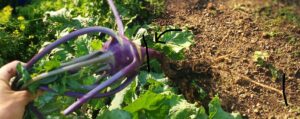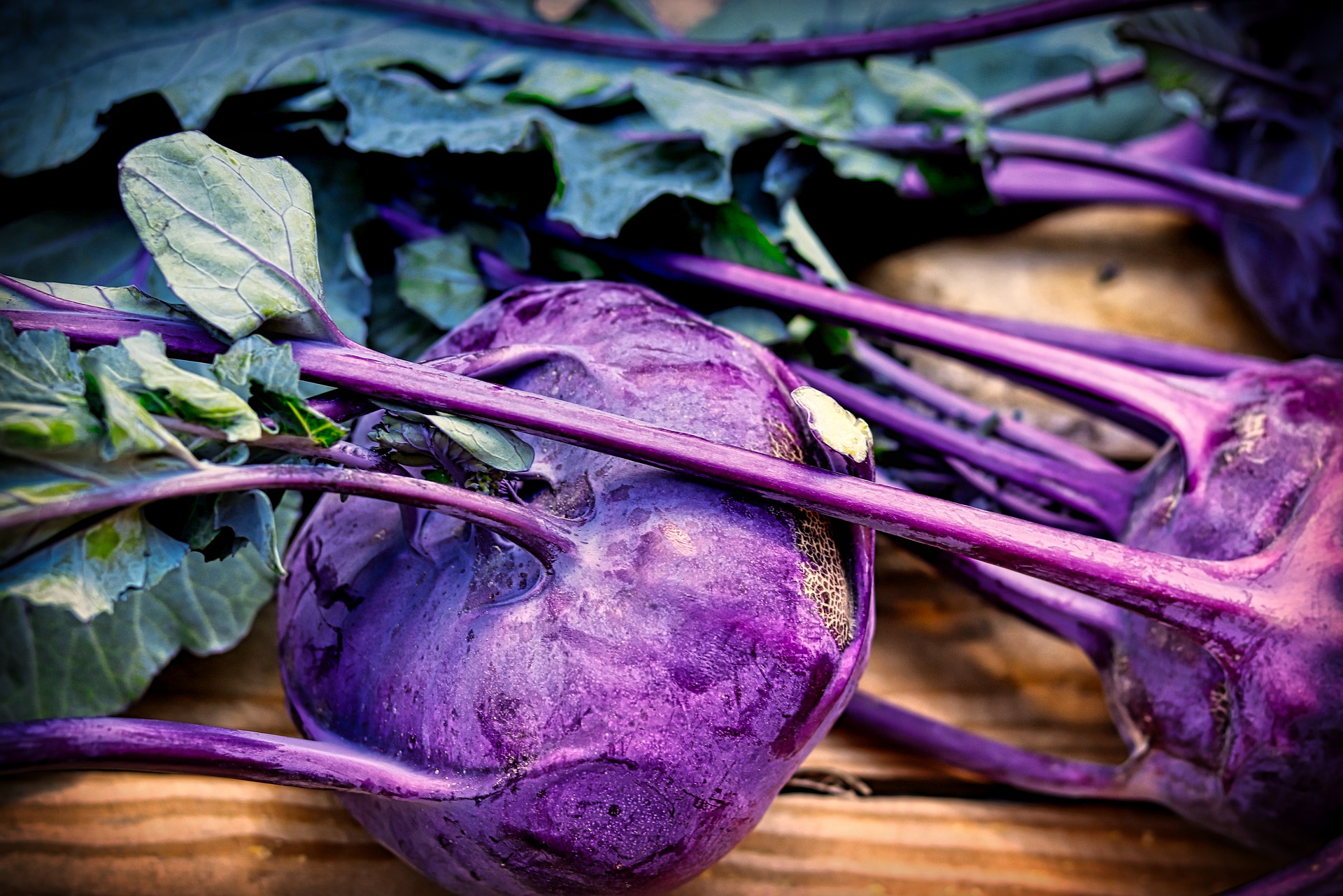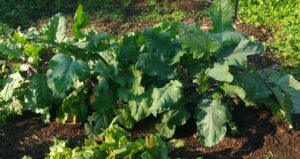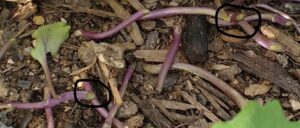My first encounter with kohlrabi wasn’t entirely positive. I remember plucking this alien-looking thing out of my CSA share box and wondering what it was and what to do with it.
It had stalks and leaves sticking out all around and the outer skin seemed too thick to make the interior worth eating. I didn’t know it back then, but that woody exterior was a symptom of growing kohlrabi in hot weather without sufficient water.
Even thick-skinned and stalky, though, the sweet centers of my first taste of kohlrabi made me realize that the vegetable had potential. Now that I know how to grow it well, it’s a staple feature in my early spring and fall garden.
The Goods on Kohlrabi
There are a few tricks to getting the most tasty and tender kohlrabi. But, if you are willing to do the work, the tasty hearts of this kale-meets-cabbage relative, will win your heart too!
Kohlrabi Is “New”
Kohlrabi’s history can only be traced back about 400–500 years.1)https://aggie-horticulture.tamu.edu/archives/parsons/publications/vegetabletravelers/kohlrabi.html Compared to its genetic parent, cabbage, which has been grown since at least 1000 BC2)https://en.wikipedia.org/wiki/Cabbage, kohlrabi is the new cabbage kid on the block.
Even though its popularity in home gardens has increased in the last 15 years, it’s still a novelty for non-gardeners. So, for any of you who haven’t sampled kohlrabi before, its name is derived from the German words for cabbage and turnip. And that’s a pretty apt description of what kohlrabi tastes like. It’s got a bit of the bite of a tangy turnip and the sweetness of a cabbage heart.
Potassium Powerhouse, Plus Vitamin C
Just 1 cup of raw kohlrabi has 140% of your daily dose of vitamin C. So, you can skip the OJ on kohlrabi days.
That same serving also has about 14% of your daily potassium, which is equivalent to what you get from a cup of goat’s milk. However, kohlrabi has less than a quarter of the calories of goat milk, or only 37 calories per cup.
It also has fair amounts of vitamin B, manganese, copper, folate, thiamine, and many other minerals. So eat up, and get your recommended daily values of good, garden-grown nutrition!3)https://nutritiondata.self.com/facts/vegetables-and-vegetable-products/2466/2
Moderately Easy to Grow
Now, growing kohlrabi isn’t quite as easy as growing mustard or kale. But, it’s a lot easier than growing large-heading cabbage. Plus, it’s not normally the cabbage moths’ “go to” option if you have other brassicas growing in your garden.
You May Also Enjoy:
“Mustard Greens: What You Need to Know Before You Grow (With Recipe)”
“All Hail, Kale! Growing Kale at Home (With Recipe)”
“Growing Cole Crops—Broccoli, Cabbage, Cauliflower, and More”
So if you love the hearts of heading cabbage, but have difficulty getting those heads to size up in your climate, kohlrabi might be your answer.
Kohlrabi in the Kitchen
Like the translation of the name implies, kohlrabi or “cabbage turnip” can be used similarly to cabbage and turnips.
Sauerkraut(ish)
You can make a kind of sauerkraut with it. Peel the kohlrabi, julienne the heart, and weigh it. Multiply your weight by 2% to figure out how much salt you need for good fermentation. Then, mix that amount of salt and the shredded kohlrabi together.
Mash them into a jar with a wooden spoon until the juices start flowing. Depending on when you harvest, kohlrabi may not have quite as much water as cabbage. So, if you can’t mash out enough liquid to make the salt brine cover the kohlrabi in your jar, add water.
Keep the kohlrabi submerged in the brine solution for a few days until it starts to smell and taste nice and fermented-funky. Eat when it tastes right for you!
You can also add a few caraway seeds to spice this simple recipe up. Don’t get carried away on the caraway though, as a little goes a long way!
Caramelized Kohlrabi
Kohlrabi becomes even sweeter if you cube it and caramelize it in a cast iron pan with a little butter (or your preferred pan fat). Get your pan good and hot, toss in your cubes, and then wait a few minutes before using a spoon to push those squares around the pan to color the other sides.
You May Also Enjoy: “Cast Iron Skillet Seasoning: How to Revive an Old Cast Iron Pan, Quickly and Easily (Video)”
Don’t stir too soon or too often. Take a deep breath and inhale the fragrance. You can actually smell the moment when kohlrabi turns the corner from turnipy to candy-like. When all sides are lightly browned, add a bit of salt and pepper, and then enjoy.
For kicks, I like to throw a few carrots in the pan with the kohlrabi. Then, I top them both off with bacon crumbles and a bit of Parmesan to upgrade this to a main course for a weeknight dinner.
Kohlrabi Slaw
If you have a favorite cole slaw recipe, just shred your kohlrabi hearts like you did for sauerkraut and substitute them for cabbage in your recipe. Kohlrabi works particularly well in Asian slaw and apple slaw recipes.
A Few Cautions About Kohlrabi
Now that your mouth is watering and you are checking out seeds online (as you read the rest of this post), let me tell you a few things you want to know before you start your own plants at home.
Cool-Season Crop
Kohlrabi is a cool-season crop. It really hates when temperatures get above 75ºF (23.9ºC). Generally, kohlrabi is better grown as a fall crop in warm climates. But if you start your seeds in soil blocks or cells indoors, you can even pull off an early spring crop in some warm climates.
Your growth rates will be slower in warm weather, though, because your plants basically stop growing each time you hit that 75ºF (23.9ºC) marker and take a day or 2 to start up again after that stress.
Cole Family
Kohlrabi is one of the easier-to-grow members of the cole family. But, it’s still susceptible to cabbage moths and clubfoot, as well as the specific boron needs that are typical of this family.
Productivity
Kohlrabi is more like cabbage than turnips in terms of its plant-spacing requirements. In other words, you won’t have great luck trying to grow multiple kohlrabi together out of one planting the way you can with turnips. So, you need to thin early and make sure each plant has a fair amount of space.
As such, despite its similarity to turnip in taste and (to some extent) appearance, it doesn’t tend to be as productive in terms of space. So, in a small garden, if I had to choose between kohlrabi and turnips, I’d go with turnips. (Thank goodness I don’t have to choose).
Growing Kohlrabi

Kohlrabi has a long tap root. Harvest by cutting the base of the bulb.
If none of those cautionary notes have deterred you and you are ready to add kohlrabi to your garden lineup, here’s what you need to know.
Soil Preparation
Kohlrabi loves deep, fertile soil with well-maintained moisture levels. It grows a fairly deep taproot. Then, the storage portion of the taproot fills out as the edible part aboveground.
For best results, incorporate well-aged compost into the top few inches of your soil before planting. Then, after the seedlings emerge, mulch around the plant to help retain moisture.
If you haven’t had your soil tested for boron lately, you might want to consider doing that before planting large plots of kohlrabi since that’s essential to good growth. Also, phosphorous will be key when the aboveground storage root begins to fatten.
I’ve had my best results when I use a 4-4-4 organic fertilizer mix at planting time. Then, when the roots start to size up, I add a tablespoon or 2 of bone meal at the root zone and water that in.
You May Also Enjoy:
Seed-Starting
I have also had the best results with kohlrabi when I direct plant. The seeds usually emerge in just a few days, with regular watering, as long as soil temperatures are at least 50ºF (10ºC).
In hot climates, though, you may need to start in cells or soil blocks to pull off spring planting. Just make sure you have the kohlrabi in the ground before the tip of the taproot reaches the outer edge of the soil space. If you wait too long to transplant, your kohlrabi root will not fatten as quickly once in the ground.
Seeds should be planted 1/4- to 1/2-inch deep. Water daily until germination. For direct seeding, I usually start 3–4 seeds together in a hole and space my plants about 4 inches apart from the center.
Thin to 1 plant as soon as your seedlings get their true leaves. Use scissors to cut extra seedlings down to the root-head level rather than pulling them out. Also, make sure to eat those early trimmings as baby greens. They’re delicious!
Plant Care
The key to good harvest is to maintain excellent moisture levels in your soil from seeding to harvest. When your roots start to fatten a bit, watch to see if they are starting to take on a rounded shape. If not, water with compost tea for a few days to stimulate root development.
You May Also Enjoy:
“Compost Tea: An Easy Way to Stretch Your Compost”
“Aerobic Compost Tea, Worm Tea, and Leachate—A Clarification”
Harvesting
For most kohlrabi, it is ready to harvest when the aboveground roots are between 2–3 inches across. However there are some larger-sized varieties available. So, check your seed package for details on harvest size.
Harvest by cutting the bottom of the heading bulb off of the tap root. You can leave the root in the ground for no-till practices. (Note: The remaining root is slower to break down than radish or turnip roots in my experience. So, if you are planting something like lettuce after kohlrabi, you might want to remove the root.)
Most varieties of kohlrabi are best eaten fresh. You can store them in the fridge for a short time if necessary. Remove the leaves to limit drying. Also, soak the kohlrabi in cool water for 10–15 minutes before putting in the crisper to keep the root firm longer.
You May Also Enjoy:
Varieties
I’ve come across probably 30 varieties of kohlrabi in my research. So, what follows is just a sample based on my experience and that of a few other gardeners I know.
Spring Planting
Early Purple and Early White Vienna are the two most common heirloom varieties of kohlrabi for spring planting.
Best Productivity
Quickstar is a hybrid variety that matures in as little as 37 days and is known for uniformity of size and good general performance in any garden. Kolibri is a hybrid purple variety with similar performance to Quickstar, except that it takes about 45 days to mature.
Fall Harvest
Delicacy White is another heirloom kohlrabi that gets a bit bigger in size, is wonderful for a fall harvest garden. But it does take closer to 60 days to mature.
Big Keeper
Kossak is a large variety that grows up to 8 inches in diameter. It’s reputed to be an excellent storage kohlrabi. The exteriors do get tough, so you won’t get to eat all that diameter. But if you want some mid-winter kohlrabi when the garden is at rest, it’s a good hybrid option.
Word of Warning
Beware, not all kohlrabi varieties consistently produce uniform round, fat bulbs. Some just sort of thicken and look a bit like a torpedo onion. They’re still tasty, but not as easy to use in the kitchen. Read the descriptions and reviews of varieties before finalizing your seed selection.
Unconventional Tips
Grow gigantic kohlrabi! According to the seed description at Baker Creek, Superschmelz or Giant White Kohlrabi will grow up to 10 inches across. I have not yet tried this giant kohlrabi, but it’s on my list for future plantings.
This does take up a lot more space in your garden than the standard kohlrabi that’s 2–3 inches in diameter. But think how much fun it will be to bust out your pumpkin-sized kohlrabi at your next family gathering!
What Do You Think?
I would love to hear if you’ve tried growing giant kohlrabi. Also, if you have any other kohlrabi secrets or cooking tips to share with our community, please use the comments section below.

Tasha Greer is a regular contributor to The Grow Network and has cowritten several e-books with Marjory Wildcraft. The author of “Grow Your Own Spices” (December 2020), she also blogs for MorningChores.com and Mother Earth News. For more tips on homesteading and herb and spice gardening, follow Tasha at Simplestead.com.











COMMENTS(2)
I grow kolrabi and have always just eaten it raw. Thanks for the recipes, I will have to try them! Can you use the leaves?
Thank you, chow 4 now.
oops…correct that to kohlrabi with an “h”